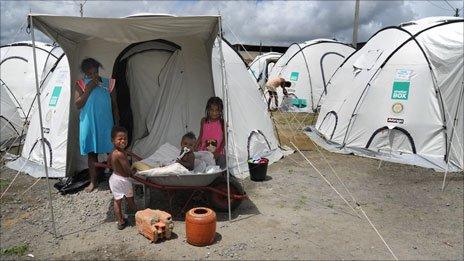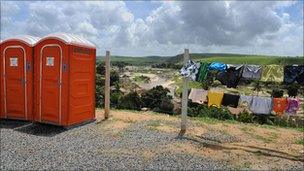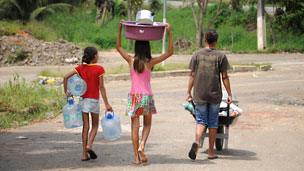Picking up the pieces after Brazil's floods
- Published

Agua Preta's homeless are being housed in camps dotted around the town
People in the Brazilian town of Agua Preta are used to coping with the elements.
But nothing could prepare them for events in June when the River Una, which flows through the town, burst its banks after days of heavy rain and began to flood the streets.
By 19 June, the town's name, Black Water, had gone from being poetic to being darkly descriptive.
"It was terrible," said Ana Lucia da Silva. "We lost most of our belongings in the flood. My house is still standing, just, but the water cracked the walls and it has been condemned."
The town had been hit in 2000 and in 1995 by flooding. But the damage then was nothing like the destruction wrought in June, said Ana Lucia.
"Last time, we could go back to our homes, but not this time."
The north-eastern states of Pernambuco and Alagoas, among the poorest regions of Brazil, bore the brunt of June's floods.
It is estimated that 181,000 people were affected in Alagoas, and 83,000 in Pernambuco. More than 40 people died.
In Agua Preta, 125km (77 miles) from Pernambuco's capital, Recife, around 3,400 were left homeless out of a population of 35,000.
Agua Preta's maternity hospital is now used to house Ana Lucia and some 100 other people.
Some families live in wooden shelters erected in the hospital grounds, while Ana Lucia is among those living inside the hospital - one family per room.
Ana Lucia was remarkably upbeat for someone who has lost so much.
"We're getting supplies. Food, water, nappies. Sometimes we get donated clothes," she said.
Ana Lucia said they were told they would have to stay in their temporary shelters for several months but they would be allocated new houses that the authorities are planning to build.
But others seemed less optimistic. Two women sitting listlessly in the shade and swatting away persistent flies complained that there had been illness.
Daily routine
More than three months on from the floods, the River Una was back to flowing serenely through the town.
But the river's edge was like a bomb site, with mangled masonry and timber strewn along the banks. The smell of damp earth mingled with the stench of untreated sewage.
Houses bore a fading yellow OK sign, reminiscent of a medieval sign for the plague, but actually a mark left in the immediate aftermath of the floods by civil defence workers to show that everyone in the building had been accounted for.

Camp residents have a view of the river that caused their distress
Agua Preta's homeless are also being housed in camps dotted around the town.
One, situated on high ground, gives its 173 residents not only a view of the river that caused their distress but a glimpse of their possible future.
The local authorities say houses will be built on a neighbouring hillside and become New Agua Preta.
But for now, people are mainly concerned with the daily routine of the camp. Health workers visit people in their tents, while officials from the state government help organise amenities and supplies.
Huge shipping containers squat on the camp's perimeter like beached whales; inside is the furniture each family managed to salvage.
Given the loss and the dislocation these people have experienced, the challenge is to make sure they care for the camp and are aware of hygiene, said Loursileide Rodrigues da Silva from the government's Operation Reconstruction programme.
"One of the biggest problems we have is with the latrines," she said.
With families forced to live so close to one another in their tents, problems can quickly arise.
"We've drawn up a letter of how people should live together, stipulating what is not acceptable, such as throwing rubbish just outside their tent, or mistreating children," said Loursileide.
"Another rule is that children are not allowed to go around without shoes," she said, as a boy of about five played merrily - and barefoot - outside his tent.
Watermarks
The government of Pernambuco says 5,000 houses are being built or have funding approved for construction. But many of those left homeless face months of camp life.
"Still today there are people who haven't recovered from the floods of 2000," said Maria de Lourdes Nascimento, from Agua Preta's Women's Association.
But she said the help from the government this time had been much better.
The scale of the rebuilding in Pernambuco becomes more evident on the approach from Agua Preta to the city of Palmares.

People are mainly concerned with the daily routine of the camp
The River Una sliced off the backs of the houses that lined the water's edge, leaving the interiors cruelly exposed.
Adeilda Severina Teixeira, whose house lies a couple of streets back from the river in Palmares, said the water reached her first floor. Some of her neighbours' houses were submerged.
Watermarks stain the walls of her home, which is still sparsely furnished and covered with a red-brown dust, the legacy of the mounds of mud deposited by the floodwaters.
In mid-September, engineers recommended the destruction of buildings within 50m of the river bank in Palmares, citing the frequency of floods in the region, local media reported.
But Adeilda said there was still great uncertainty in her neighbourhood about the future.
"I don't know yet if my house is considered safe," she said.
As in Agua Preta, camps have been set up to house those left without shelter.
But Adeilda said she knew of several people returning to their flood-damaged homes or squeezing in with relatives rather than stay in the tents.
"It's just too humiliating in the camps, having to queue for everything," said Adeilda, as she busied herself preparing lunch for her son in the cramped kitchen.
Nearby, the River Una flowed on, quiet and brown.
- Published23 June 2010
- Published20 June 2010